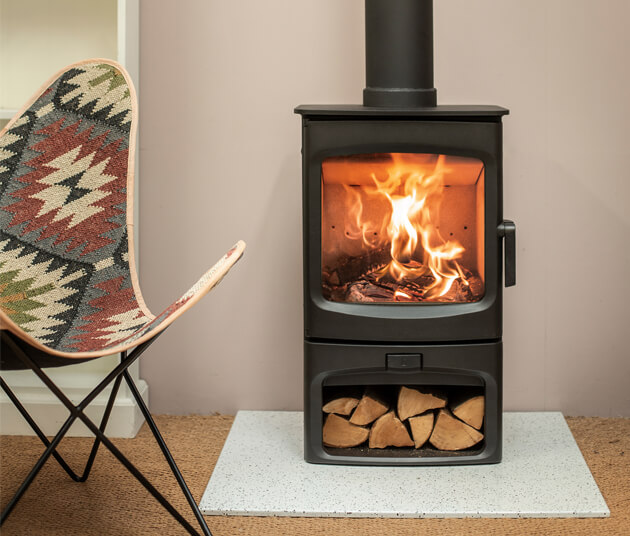The warmth you get from a wood burning stove is like no other, it truly is the epitome of comfort. But how do you get heat from your wood burning stove to fill your whole house and not just the one room? This article talks you through some of the most popular options…
Are you getting the best from your stove?
You want to be sure your wood burning stove is giving you its best and there are ways you can help it along. Keeping your stove and flue clean and maintained will help your system run efficiently, so be sure to sweep away any debris and excess ash (a couple of centimetres is fine), and you need to have your chimney swept at least once a year.
Be sure to use properly dried and seasoned wood (less than 20% moisture) and, when starting your fire, start with a bed of kindling, ensuring it is glowing hot before adding some small logs and then, later, a full load of wood. Take care not to overfill your stove as this can cause dangerously high temperatures and can cause damage to your stove. The inside of your stove should be between 260°C and 460°C.
You’ll also want to circulate the heat your wood burning stove produces, which we’ll cover in more detail a little later in this article.
Also learn more on how to use a wood-burning stove.
How much heat does a wood burning stove produce?
The heat from wood burning stoves is measured in kWh (kiloWatt hours) or BTUs (British Thermal Units), where 1kWh equals approximately 3,400 BTUs.
Wood burning stoves are often displayed with two heat output figures; the maximum heat output and the nominal heat output. The former is quite simply the maximum heat output you can achieve with that wood burning stove, while nominal output is the level of heat you can get out of it while running the wood burning stove as its efficiency rating.
Wood stoves can put out up to around 15kW (51,000 BTUs) of heat with their air vents wide open (assuming it is a 3 or 4-cubic-foot firebox and is well-stocked and running efficiently), while this can drop to around 4kW (14,000 BTUs) if the vents are closed and the wood smoulders rather than burns. How well your wood burning stove heats your room (or your house) will depend on your room size, house size and layout, and stove size and efficiency, although there are ways to improve how the heat warms your home.
Best tips for spreading heat from a wood burning stove around your home
There are a number of ways you can help spread the heat from your wood burner so it reaches more of your home. We discuss some of the best ways below.
Using a fan to circulate heat
Heat rises, pure and simple. It’s one of those immutable laws of the universe, but that doesn’t mean you can’t move it around. A fan sits on top of your wood burning stove and the heat from your stove will cause the fan to spin (no need to plug anything in!) and subsequently move the heat around the room. Because the fan helps the heat reach parts of your room more quickly, you can use less wood than you previously may have done to generate the same amount of heat, saving you money.
The best place to put your fan is on one of the back corners of the stove as the front of the fan will get the full effect of the heat from underneath while the back of the fan will be cooler; the heat difference will help move your fan blades more quickly and spread your stove heat further.
Directing heat to where it is needed
As we’ve already mentioned, heat rises, and you can use that to your advantage. Having your wood burning stove installed on the ground floor of your home means the heat will rise to the higher storey(s) in your house, warming your bedrooms.
You can help the heat get into your upstairs room by installing vents in the ceiling of the room where the stove is, and vents in the rooms you want to benefit from the stove’s heat.
You should consult a professional when adding vents to your home; this helps maximise the efficiency of the venting system and also helps you steer clear of any potential safety hazards.
Also explore our Wood-Burning Stove FAQs.
Adding duct for wood stove heat distribution
Having proper ducting installed from your wood stove to other parts of your house pulls cold air from those far-reaching rooms towards the stove, causing the stove to release warm air. This means the heat from the wood burner isn’t wasted on heating up the duct but instead uses the natural flow of hot and cold air to help warm the rooms further out from the stove.
Also explore the essential wood-burning stove tips.
Why choose us?
Charnwood has been committed to providing quality wood burning stoves since 1972 and we know all there is to know about wood burners. If you have any questions about heating your home with a wood burning stove, please get in touch

